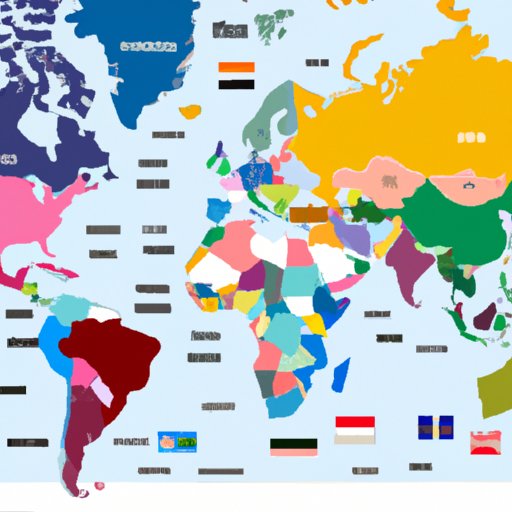Introduction
When discussing the nations of the world, it is important to first understand what constitutes a country. According to the Merriam-Webster dictionary, a country is defined as “an independent political unit having its own government, occupying a particular territory, and possessing internal and external sovereignty.” With this definition in mind, the question remains: how many countries are there in the world?
A Comprehensive List of Countries in the World
In order to answer this question, it is important to consider the various types of countries that exist. The most widely accepted list of countries is provided by the United Nations (UN), which currently recognizes 193 member states. These are the countries that are officially recognized by the UN, and include all of the world’s major powers, such as the United States, China, Russia, India, and the UK. In addition to these 193 countries, there are also several other states and dependencies that are not members of the UN, but are nonetheless recognized by other nations or international organizations. These include Taiwan, Palestine, Kosovo, and Western Sahara, among others.
In addition to these recognized states and dependencies, there are also several disputed territories that are claimed by multiple countries. The most notable of these are the Kashmir region between India and Pakistan, the Golan Heights between Israel and Syria, and the Falkland Islands between the UK and Argentina. While these areas may be considered countries by some, they are not officially recognized as such by the UN or any other international body.
Exploring the Nations of the World: How Many Countries Are There?
Given the different types of countries discussed above, there are several different ways to count the number of countries in the world. The most widely accepted way is to count by UN membership, which would yield a total of 193 countries. This is the number that is most commonly cited when discussing the nations of the world.
Another way to count the number of countries is to count by recognition. This method would include all 193 UN member states, as well as the various other states and dependencies that are recognized by other nations or international organizations. This would bring the total to around 200 countries, depending on which entities are included in the count.
Finally, one could count the number of countries by population. This would include all 193 UN member states, as well as any entities with a population of at least 1 million people. This would bring the total to around 210 countries, depending on which entities are included in the count.

Mapping the Globe: An Overview of All Nations
Once the total number of countries has been determined, it is helpful to have a visual representation of the nations of the world. One way to do this is through the use of maps. Political maps provide a clear picture of the boundaries between countries, while physical maps show the geographical features of each nation. Climate maps can also be used to illustrate the average temperatures and precipitation levels of different regions.

A Visual Guide to the Countries of the World
Maps are not the only way to gain insight into the countries of the world. Flags are a powerful symbol of national identity, and can be used to learn about the history and culture of a country. Similarly, symbols such as coats of arms, national animals, and traditional dishes can provide insight into the unique character of each nation.
A Global Tour: An Overview of the World’s Countries
Finally, it is interesting to explore the various regions, geographies, and histories of the world’s countries. Each nation has its own unique characteristics, from the deserts of Africa to the rainforests of South America. Exploring the world’s countries can provide insight into the diversity of human life and culture on our planet.
Conclusion
In conclusion, it is difficult to give an exact answer to the question of how many countries are in the world. Depending on the method used to count them, the number can range from 193 to around 210. However, no matter how they are counted, it is clear that the nations of the world represent a remarkable diversity of cultures, geographies, and histories. For those interested in learning more about the countries of the world, there are many resources available, including maps, flags, symbols, and cultural guides.


